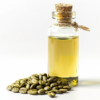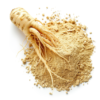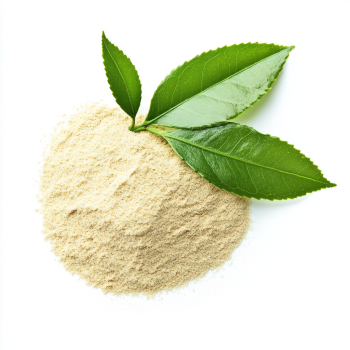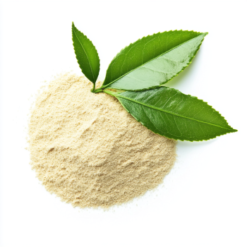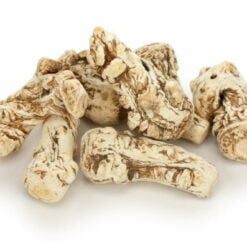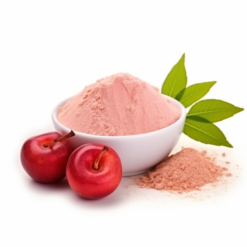Uses and Properties of Green Tea Extract
Green tea is widely appreciated for its health-promoting properties, which is why many people drink it. Green tea extract enjoys a similar reputation — it supports fat metabolism, helps the body fight harmful free radicals, protects the skin from UV radiation, and helps maintain proper cholesterol levels in the blood. Green tea extract is especially recommended for people undergoing a weight-loss process. Green tea also contains some caffeine, which gives it a stimulating effect. It not only provides energy but also boosts metabolism.
Green tea, obtained from unfermented leaves of the Chinese tea plant (Camellia sinensis), is considered one of the healthiest beverages in the world. The extract derived from it is characterized not only by valuable medicinal properties but also by wide application in the cosmetic industry.
Polyphenolic Compounds in Green Tea
The properties of green tea result primarily from its high content of polyphenolic compounds. The flavonoid content may reach up to 30–36% of the dry weight of the leaves. The most important role is played by catechin compounds (flavanols), which make up about 80% of the flavonoid group: epigallocatechin gallate, epigallocatechin, epicatechin gallate, and epicatechin.
These compounds are characterized by very strong antioxidant activity, resulting from their ability to scavenge and reduce the production of free radicals, as well as their anti-swelling effect valued in cosmetics.
Additionally, at lower concentrations, other flavonoids are also present — kaempferol, rutin, quercetin, myricetin, and their glycosides — which show, among other things, antioxidant properties and inhibition of platelet aggregation.
Medicinal Properties of Green Tea
Due to its chemical composition, green tea extract is widely used in the food and pharmaceutical industries. Drinking green tea or taking the extract as a dietary supplement (capsules, tablets) is particularly recommended for people who want to lose excess weight and support cardiovascular disease prevention. Green tea extract has anti-atherosclerotic effects, protects blood vessels, lowers cholesterol and triglyceride levels, inhibits fat cell growth, and reduces fat absorption. These properties make regular intake of green tea extract beneficial for stabilizing body weight, preventing fat accumulation, and reducing the risk of cardiovascular diseases.
Other beneficial properties of the extract include its neuroprotective effects. Its antioxidant, vasodilating, and detoxifying properties (ability to chelate metal ions) place it among potential therapeutic agents for Alzheimer’s disease, Parkinson’s disease, and progressive sclerosis. Research results also indicate possible anticancer activity of the extract, supported by statistics showing a correlation between high green tea consumption in Asian countries and low incidence of cancer.
Cosmetic Properties of Green Tea Extract
Green tea extract does not have to be taken orally only. It also has beneficial effects on the skin and its appendages, which makes it a valued ingredient in the pharmaceutical and cosmetic industries.
Compounds contained in green tea extract show a variety of properties such as:
- anti-inflammatory,
- antibacterial,
- antioxidant,
- improving skin microcirculation,
- reducing sebaceous gland activity.
Therefore, it can be found in toners, moisturizing lotions, hair care products, shower gels, and moisturizing creams.
In cosmetics, green tea extract demonstrates a very wide range of effects. Its strong moisturizing and antioxidant properties make it a suitable ingredient in anti-aging preparations for mature skin, and at the same time, thanks to its sebum-regulating and antibacterial properties, it is valued in cosmetics for young, acne-prone skin.
These properties are also linked to the possibility of using green tea extract in hair and scalp care — it works as an anti-dandruff agent and reduces greasiness.
It can also be applied to the skin for more therapeutic purposes — it soothes irritations, reduces swelling and redness, supports wound healing, and has anti-inflammatory effects. This latter property is also used in intimate hygiene liquids and preparations for eye care.
Products containing green tea extract will also be appreciated by lovers of healthy tanning — during sun exposure, it protects against harmful UV radiation, and by stimulating melanin synthesis, it also works as a natural ingredient in self-tanning products.
Bibliografia:
- Arct J, Tomaszewska K, Pytkowska K (2016). Zielona Herbata. Pol J Cosmetol, 19(2): 110-115
- Całka J, Zasadowski A, Juranek J. (2008). Niektóre aspekty leczniczego działania zielonej herbaty. Bromat. Chem. Toksykol, 41: 5-14.
- Matysek-Nawrocka M, Cyrankiewicz P. (2016). Substancje biologicznie aktywne pozyskiwane z herbaty, kawy i kakao oraz ich zastosowanie w kosmetykach. Post Fitoter, 17(2): 139-144.
ARTICLE AUTHOR:
DR. KATARZYNA KIMEL
Doctor of Pharmaceutical Sciences, whose scientific interests focus on research on herbal medicines and biologically active substances of natural origin. A lover of travel and spending free time in nature.


